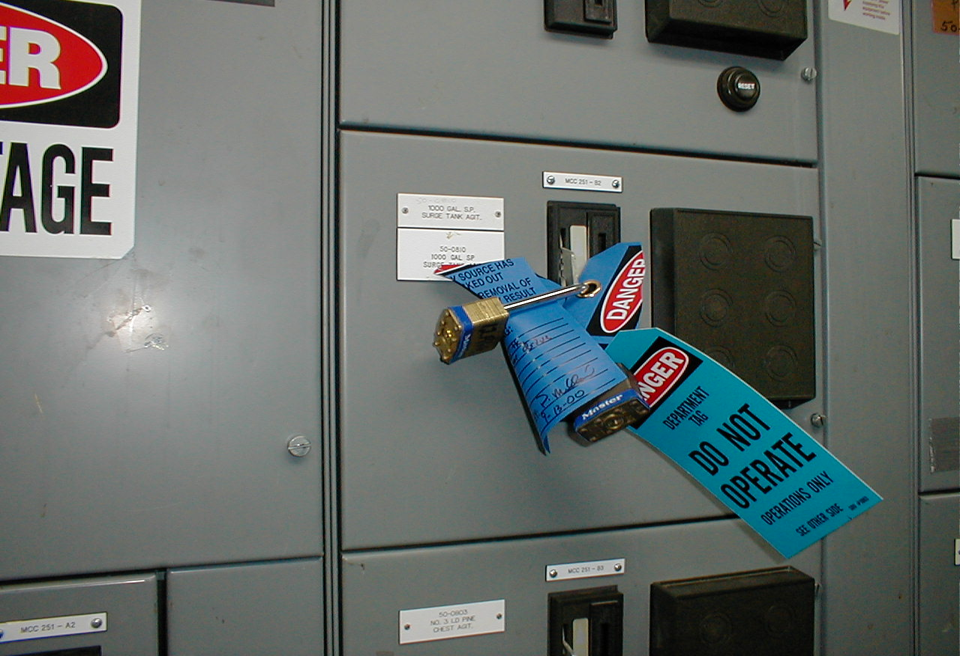
Controlling Hazardous Energy: The Unexpected Danger
Published on June 24, 2021An employee is changing a ballast in an overhead light fixture in a break room. The employee turns off the light switch. Working from an eight-foot step ladder, the employee begins the ballast replacement. As the employee is completing the electrical connections, a second employee enters the dark break room. Unaware of the work being performed on the overhead light, the second employee flips the light switch to turn on the lights. The first employee suffers a minor electric shock which triggers a fall from the ladder. During the fall, the employee reaches out to brace for landing which results in a broken wrist. The injury requires surgery and the employee is hospitalized overnight.
Lock Out Tag Out Procedures
While the previous scenario is hypothetical, it accurately portrays the potential injuries that may occur when hazardous energy is not controlled. Hazardous energy can be electrical, mechanical, pneumatic, chemical, thermal, or other energy that when not properly controlled or relieved can cause equipment to operate unexpectedly. In the example, the employee servicing the light should have isolated the electrical circuit at the breaker and initiated a Lock Out Tag Out (LOTO) procedure. Isolating the electrical supply at the breaker would have prevented the injury that occurred when the light switch was activated. However, simply turning the power off at the breaker is not sufficient.
Whenever outside servicing personnel are to be engaged in activities covered by the scope and application of this standard, the on-site employer and the outside employer shall inform each other of their respective lockout or tagout procedures. A device that utilizes a positive means such as a lock, either key or combination type, to hold an energy isolating device in the safe position and prevent the energizing of a machine or equipment must also be installed.
What OSHA Requires
The standard related to the control of Hazardous Energy can be found in 29.CFR.1910.147. This standard requires employers to develop a LOTO policy when the servicing and maintenance of machines and equipment in which the unexpected energization or startup of the machines or equipment, or release of stored energy, could harm employees. Employers must establish a program and utilize procedures for affixing appropriate lockout devices or tagout devices to energy isolating devices, and to otherwise disable machines or equipment to prevent unexpected energization, start up, or release of energy to prevent injury to employees.
A key element of a LOTO program is a written policy. In addition, the standard requires employers to develop energy control procedures, meaning methods to shut down and service equipment must be documented. For example, if an air conditioning unit needs to be serviced, the process to turn off the power needs to include the name/location of the breaker panel and breaker number in the panel. If systems have multiple sources of energy, then the control procedure must detail the methods to isolate all sources of energy. Prior to starting work on machines or equipment that have been locked out or tagged out, the employee must verify that isolation and de-energization of the equipment has been accomplished.
Other key elements of the LOTO program include employee training and periodic inspection of the LOTO procedures. Training is required upon job assignment and must include training in the recognition of hazardous energy sources, the type and magnitude of the energy available in the workplace, and the methods and means necessary for energy isolation and control. Further training is required when the scope of the job changes, new machinery is installed, or there are changes in processes that may present a new hazard.
The periodic inspection is simply an annual audit of those procedures to verify the procedures are accurate or identify changes or corrections that must be made to the procedure.
The marina owner or operator must also consider LOTO procedures for contractors. Outside contractors should implement their own LOTO procedures when working on systems such as electrical, HVAC, fuel systems, or other equipment. Whenever outside servicing personnel are to be engaged in activities covered by the scope and application of the LOTO standard, the on-site employer and the outside employer must inform each other of their respective lockout or tagout procedures.
Final Thoughts
The accident scenario above presents many issues for the employer. First, due to the overnight hospitalization, the accident must be reported to OSHA within 24 hours in most cases (a few variations exist by state). The reported accident may trigger a visit from an OSHA Compliance Safety and Health Officer (CHSO). Assuming the worst case scenario, the example above could yield a citation for failing to establish a written LOTO program (1910.147(a)(3)(i)), failing to have energy control procedures (1910.147(c)(4)(i)), failure to have protective hardware such a locks and tags (1910.147(c)(5)(i), failure to perform the periodic inspection (1910.147(c)(6)(i)), and a failure to train employees (1910.147(c)(7)(i)). Each one of the five possible citations could be penalized up to $13,653 per violation.
| Categories | |
| Tags |




